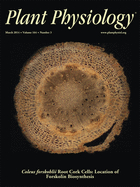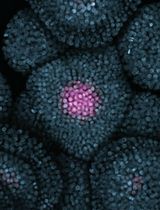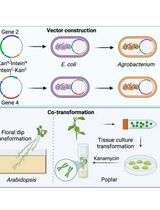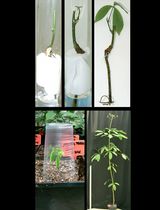- EN - English
- CN - 中文
Agrobacterium tumefaciens-mediated Transformation of Walnut (Juglans regia)
农杆菌介导的核桃转化
发布: 2014年10月05日第4卷第19期 DOI: 10.21769/BioProtoc.1258 浏览次数: 14053
Abstract
Like many woody plant species, walnut (Juglans regia) can be difficult to genetically transform and regenerate. However, somatic embryos have been used successfully for over two decades as a target tissue for transformation and regeneration of transgenic walnut plants. Walnut somatic embryos, initiated originally from developing zygotic embryos or anther tissue, will proliferate numerous secondary embryos from single cells in the epidermal layer. These single cells in intact somatic embryos can be efficiently transformed by Agrobacterium tumefaciens (A. tumefaciens). This gene transfer system is most efficient when Agrobacterium binary vector plasmids contain a scorable maker gene (e.g. uidA) and a selectable marker gene (e.g. nptII). This system should be applicable to any crop that undergoes repetitive embryogenesis from single Agrobacterium-susceptible cells. Here we describe the method of transforming somatic embryos in detail so that this technique can be applied to walnut and other woody plant species.
Materials and Reagents
- Biological materials
- Juglans regia somatic embryo cultures
- Disarmed A. tumefaciens strain (e.g. EHA101) harboring binary vector of interest
For this protocol it is assumed that the vector harbors the nptII selectable marker gene and the uidA scorable marker gene (e.g. pDE00.0201 from Escobar et al., 2002).
- Juglans regia somatic embryo cultures
- Chemicals
- Driver Kuniyuki walnut (DKW) medium with vitamins (PhytoTechnology Laboratories®, catalog number: D2470 )
- Kanamycin sulfate (PhytoTechnology Laboratories®, catalog number: K378 )
- Timentin® (PhytoTechnology Laboratories®, catalog number: T869 )
- 4-Hydroxy-3',5'-dimethoxyacetophenone (Acetosyringone) (PhytoTechnology Laboratories®, catalog number: A104 )
- GelzanTM CM (Sigma-Aldrich, catalog number: G1910 )
- SeaKem® LE agarose (Lonza, catalog number: 50004 )
- Bacto® Agar/SuperPureTM agar (BTS, catalog number: A01PD )
- Proline (PhytoTechnology Laboratories®, catalog number: D689 )
- 5-Bromo-4-chloro-3-indolyl β-D-glucuronide (X-gluc) (Sigma-Aldrich, catalog number: B5285 )
- 1 M sodium phosphate buffer (pH 7.0)
- 0.5 M EDTA (pH 8.0) (PhytoTechnology Laboratories®, catalog number: E 582 )
- 0.005 M potassium ferricyanide (Sigma-Aldrich, catalog number: 702587 )
- 0.005 M potassium ferrocyanide (Sigma-Aldrich, catalog number: P3289 )
- Triton X-100 (Sigma-Aldrich, catalog number: 234729 )
- Indole-3-butyric acid (IBA) (Sigma-Aldrich, catalog number: B-5386 )
- 6-Benzylaminopurine (BAP) (Sigma-Aldrich, catalog number: B-3408 )
- Tryptone (BTS, catalog number: T01PD )
- Yeast extract (BTS, catalog number: Y02MG )
- NaCl (Thermo Fisher Scientific, catalog number: S271-3 )
- Saturated ZnSO4 or NH4NO3 solution
- 10x PCR buffer (Applied Biosystems)
- PCR primers
- dNTPs (Applied Biosystems)
- Taq DNA polymerase (Applied Biosystems)
- DNeasy Plant Mini Kit (QIAGEN)
- Driver Kuniyuki walnut (DKW) medium with vitamins (PhytoTechnology Laboratories®, catalog number: D2470 )
- Media and supplements
Microbiological media- Agrobacterium liquid growth medium (LB liquid medium) (see Recipes)
- Agrobacterium growth plates (LB solid medium) (see Recipes)
Plant media- Driver Kuniyuki walnut (DKW) basal medium (see Recipes)
- Virulence induction medium (IM) (see Recipes)
- Acetosyringone medium (AS) plates (see Recipes)
- KAN/Timentin® selection medium (see Recipes)
- KAN only selection medium (see Recipes)
- DKW shoot medium (DKW basal medium with 1 mg/L BAP and 0.01 mg/L IBA) (see Recipes)
- Agrobacterium liquid growth medium (LB liquid medium) (see Recipes)
- Glass and Plasticware
- Sterile empty 100 x 15 mm Petri plates (VWR International, catalog number: 25384-342 )
- Sterile empty 35 x 10 mm Petri plates (BD, FalconTM, catalog number: 25373-041 )
- Sterile disposable 50 ml screw-cap centrifuge tubes (BD, FalconTM, catalog number: 352070 )
- Sterile disposable cotton-plugged 10 ml pipettes
- Plastic pipette tips (20, 200, and 1,000 µl) (Rainin, model: LTS )
- Sterile disposable 6-well multiwell plates (BD Biosciences, Falcon®, catalog number: 08-772-1G )
- Sterile disposable 96-well multiwell plates (BD Biosciences, Falcon®, catalog number: 08-772-2C )
- Filter paper cut to fit in 100 x 15 mm Petri plates and autoclaved
- Filter paper discs cut to the diameter of the wells of a 6-well multiwall plate and autoclaved
- 150 mm diameter desiccator (e.g. Nalgene, catalog number: 5313-0150 )
- Magenta GA-7 vessels (Magenta Corp.)
- Sterile empty 100 x 15 mm Petri plates (VWR International, catalog number: 25384-342 )
Equipment
- Spectrophotometer (e.g. Bio-Rad Laboratories, model: SmartSpec 3000 )
- Laboratory centrifuge (e.g. Sigma-Aldrich, Laborzentrifugen Laboratory Centrifuge 3K 10 )
- Micro-centrifuge (e.g. Denville, model: 260D )
- Continuous power supply units for electrophoresis (e.g. Thermo EC, model: EC 105 and Hoefer, model: HE 33 Mini Submarine unit)
- Electrophoresis units for agarose gels (e.g. Fisher Scientific, models: 03-500-124 , 03-500-132 , and 03-500-134 )
- Laminar flow hood (e.g. EdgeGard, Baker, model: EG3252 )
- Pipetman® 20, 200, and 1,000 µl (Rainin, model: LTS )
- Analytical balance (e.g. Mettler Toledo, model: AT261 DeltaRange® )
- Top loading electronic balance (e.g. Mettler, model: PM 2000 )
- pH meter (e.g. Corning Pinnacle, model: 540 )
- Constant temperature incubator (e.g. Napco, model: 301 )
- Water baths (e.g.Thermo Scientific, model: 2870 )
- Vortex mixer (e.g.: Scientific Industries, model: G 560 )
- Freezer (- 80 °C) (e.g. New Brunswick, model: U 700 Premium)
Procedure
文章信息
版权信息
© 2014 The Authors; exclusive licensee Bio-protocol LLC.
如何引用
Readers should cite both the Bio-protocol article and the original research article where this protocol was used:
- Walawage, S. L., Leslie, C. A., Escobar, M. A. and Dandekar, A. M. (2014). Agrobacterium tumefaciens-mediated Transformation of Walnut (Juglans regia). Bio-protocol 4(19): e1258. DOI: 10.21769/BioProtoc.1258.
- Araji, S., Grammer, T. A., Gertzen, R., Anderson, S. D., Mikulic-Petkovsek, M., Veberic, R., Phu, M. L., Solar, A., Leslie, C. A., Dandekar, A. M. and Escobar, M. A. (2014). Novel roles for the polyphenol oxidase enzyme in secondary metabolism and the regulation of cell death in walnut. Plant Physiol 164(3): 1191-1203.
分类
植物科学 > 植物转化 > 农杆菌介导的转化方法
植物科学 > 植物发育生物学 > 综合
分子生物学 > DNA > 转化
您对这篇实验方法有问题吗?
在此处发布您的问题,我们将邀请本文作者来回答。同时,我们会将您的问题发布到Bio-protocol Exchange,以便寻求社区成员的帮助。
Share
Bluesky
X
Copy link













